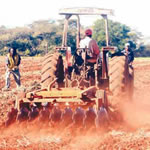Leaving land derelict unsound for economy

, backed by the British Expeditionary Force, seized more than 75 percent of Zimbabwe’s arable land.
In the process more than 90 percent of the indigenous population was forcibly restricted to less than 24 percent of land located in the marginal and less productive ecological zones of the country.
This set-up was to later serve as the springboard for the Second Chimurenga that culminated in Zimbabwe gaining independence in 1980 – of course at a cost of more than 50 000 lives.
Similarly, the land question dominated negotiations at the Lancaster House Conference in 1979, which had a three-week deadlock and almost collapsed until the British and US governments made undertakings to the effect that they would fund Zimbabwe’s land reform programme.
Since then, a lot has happened with Britain honouring part of its obligations and reneging on the other.
Zimbabwe went ahead and compulsorily acquired land to resettle its landless majority and to date more than 300 000 families have been successfully resettled on prime land.
This was done on the understanding that it is on land that the indigenisation of the economy would be built and that it is on land too that surplus capital can be generated for investment in industry, mining and commerce.
Agriculture would produce the primary materials industry needs to function productively, the effects of which would cascade into most sectors of economy.
The smallholder farmers had aptly demonstrated that they were a major force in commercial agriculture production if given access to key requirements that include finance, infrastructure and extension services.
And between 1980 and 1996 the maize output from smallholder producers shot from 35 percent to 63 percent of the total national production while cotton production also rose from 26 percent to 70 percent in the marginal regions of the country.
Today, 11 years after the successful implementation of the agrarian reforms a lot has happened in the agricultural sector and the production landscape has since changed. Production of most crops has since soared and so have the earnings from the sector.
Many farmers, especially from the A2 group, have made huge investments both in infrastructure and machinery on their farms and have even diversified from food crops to cash crops that command respect in overseas markets.
This is good for the country.
Areas that used to be considered elitist have since seen the new farmers coming in and have fared relatively well in some cases although the commonest hurdle has been that of funding and lack of lucrative markets.
This development has also come with lessons that the size of land is not what matters most in farming but the way it is managed to get the best out of it. Some farmers are doing exceptionally well on very small pieces of land while the other group has vast expanses of land with only a fraction being utilised.
Incidentally, this is a development that has become a worrying issue at the moment. Most of the under-utilised land is found on most of the big commercial farms and not the small-scale.
In some cases some of the newly resettled farmers were fortunate to inherit thriving enterprises, especially in horticulture and other crops. But they did not even care to manage and maintain them as their cash cows and consequently the projects are now in ruins, yet the farmers are constantly reeling from serious financial woes.
Some farmers are in the habit of using just a part of their land and have not even cared to use, let alone explore, some of the portions since acquiring the farms, maybe as far back 2000.
Under such circumstances, it would be noble for Government to take the Third Chimurenga a step further and designate the unused parts and give them to those still seeking land.
There are many genuine farmers who were unable to get adequate land and are currently squashed onto very small hectarages where they can not fully express their potential.
In fact, such farmers end up committing all their resources to the production of food crops that literally do not have high market value even if they are to sell the surplus to improve their socio-economic reality.
This does not mean that the under-achievers get the whole farm taken from them, but just that part that is not being utilised.
Leaving huge chunks of land derelict is tantamount to replicating the colonial situation in which a minority had access to the best land but did not use it in its entirety.
Today, there are still thousands of Zimbabweans seeking just a small piece of land to grow a food crop plus a cash crop to guarantee themselves of both food security and some income to meet some of their socio-economic concerns.
It is only logical for all land that is lying idle to be allocated to those who failed to get their share under the land reform programme and allow them to contribute to the development of the economy.
Most of the culprits are keeping the land for speculative purposes and brag about the vast farms they “own” at the slightest opportunity.
One sad reality with most of the farmers keeping some tracts of land unused is that they are concentrating on cash crops rather than food crops that help boost the food security of the country.
Indeed, the country needs the cash crops as most of them do very well in export markets but the fact remains that the country still needs food and that is one area where smallholder farmers deserve to be given credit.
Smallholder farmers, the majority of whom find it difficult to acquire land, usually prioritise food crops to take care of their domestic needs before selling the surplus that ends up in the national silos.
Most big farmers are concentrating on tobacco and soya beans in the wake of the good prices the crops are fetching.
In the end they just commit all the land they can till to those crops and in most cases they leave just a few hectares for maize.









Comments